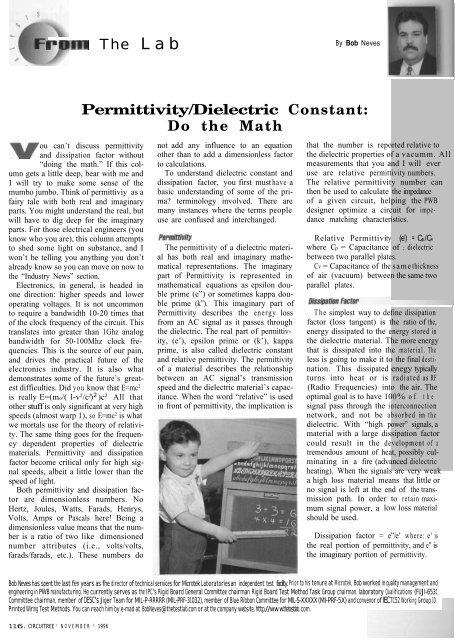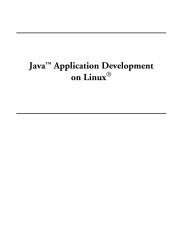Permittivity/Dielectric Constant: Do The math - Dator
Permittivity/Dielectric Constant: Do The math - Dator
Permittivity/Dielectric Constant: Do The math - Dator
You also want an ePaper? Increase the reach of your titles
YUMPU automatically turns print PDFs into web optimized ePapers that Google loves.
am <strong>The</strong> Lab<br />
By Bob Neves<br />
ou can’t discuss permittivity<br />
and dissipation factor without<br />
“doing the <strong>math</strong>.” If this column<br />
gets a little deep, bear with me and<br />
I will try to make some sense of the<br />
mumbo jumbo. Think of permittiviy as a<br />
fairy tale with both real and imaginary<br />
parts. You might understand the real, but<br />
will have to dig deep for the imaginary<br />
parts. For those electrical engineers (you<br />
know who you are), this column attempts<br />
to shed some light on substance, and I<br />
won’t be telling you anything you don’t<br />
already know so you can move on now to<br />
the “Industry News” section.<br />
Electronics, in general, is headed in<br />
one direction: higher speeds and lower<br />
operating voltages. It is not uncommon<br />
to require a bandwidth 10-20 times that<br />
of the clock frequency of the circuit. This<br />
translates into greater than 1Ghz analog<br />
bandwidth for 50-100Mhz clock frequencies.<br />
This is the source of our pain,<br />
and drives the practical future of the<br />
electronics industry. It is also what<br />
demonstrates some of the future’s greatest<br />
difficulties. Did you know that E=mc 2<br />
is really E=(mo/( l-v 2 /c 2 ) Ö2 )))c 2 All that<br />
other stuff is only significant at very high<br />
speeds (almost warp 1), so E=mc 2 is what<br />
we mortals use for the theory of relativity.<br />
<strong>The</strong> same thing goes for the frequency<br />
dependent properties of dielectric<br />
materials. <strong>Permittivity</strong> and dissipation<br />
factor become critical only for high signal<br />
speeds, albeit a little lower than the<br />
speed of light.<br />
Both permittivity and dissipation factor<br />
are dimensionless numbers. No<br />
Hertz, Joules, Watts, Farads, Henrys,<br />
Volts, Amps or Pascals here! Being a<br />
dimensionless value means that the number<br />
is a ratio of two like dimensioned<br />
number attributes (i.e., volts/volts,<br />
farads/farads, etc.). <strong>The</strong>se numbers do<br />
<strong>Permittivity</strong>/<strong>Dielectric</strong> <strong>Constant</strong>:<br />
<strong>Do</strong> the Math<br />
not add any influence to an equation<br />
other than to add a dimensionless factor<br />
to calculations.<br />
To understand dielectric constant and<br />
dissipation factor, you first must have a<br />
basic understanding of some of the prima?<br />
terminology involved. <strong>The</strong>re are<br />
many instances where the terms people<br />
use are confused and interchanged.<br />
<strong>The</strong> permittivity of a dielectric material<br />
has both real and imaginary <strong>math</strong>ematical<br />
representations. <strong>The</strong> imaginary<br />
part of <strong>Permittivity</strong> is represented in<br />
<strong>math</strong>ematical equations as epsilon double<br />
prime (e”) or sometimes kappa double<br />
prime (k”). This imaginary part of<br />
<strong>Permittivity</strong> describes the energy loss<br />
from an AC signal as it passes through<br />
the dielectric. <strong>The</strong> real part of permittivity,<br />
(e’), epsilon prime or (k’), kappa<br />
prime, is also called dielectric constant<br />
and relative permittivity. <strong>The</strong> permittivity<br />
of a material describes the relationship<br />
between an AC signal’s transmission<br />
speed and the dielectric material’s capacitance.<br />
When the word “relative” is used<br />
in front of permittivity, the implication is<br />
that the number is reported relative to<br />
the dielectric properties of a vacumm. All<br />
measurements that you and I will ever<br />
use are relative permittivity numbers.<br />
<strong>The</strong> relative permittivity number can<br />
then be used to calculate the impedance<br />
of a given circuit, helping the PWB<br />
designer optimize a circuit for impedance<br />
matching characteristics.<br />
Relative Permittivi ty (e’) = Cp / Cv<br />
where Cp = Capacitance of ; dielectric<br />
between two parallel plates.<br />
Cv = Capacitance of the same thickness<br />
of air (vacuum) between the same two<br />
parallel plates.<br />
<strong>The</strong> simplest way to define dissipation<br />
factor (loss tangent) is the ratio of the,<br />
energy dissipated to the energy stored in<br />
the dielectric material. <strong>The</strong> more energy<br />
that is dissipated into the material. <strong>The</strong><br />
less is going to make it to the final destination.<br />
This dissipated enegy typically<br />
turns into heat or is radiated as RF<br />
(Radio Frequencies) into the air. <strong>The</strong><br />
optimal goal is to have 100 % of t h e<br />
signal pass through the interconnection<br />
network, and not be absorbed in the<br />
dielectric. With “high power” signals, a<br />
material with a large dissipation factor<br />
could result in the development of a<br />
tremendous amount of heat, possibly culminating<br />
in a fire (advanced dielectric<br />
heating). When the signals are very weak<br />
a high loss material means that little or<br />
no signal is left at the end of the transmission<br />
path. In order to retain maximum<br />
signal power, a low loss material<br />
should be used.<br />
Dissipation factor = e”/e’ where: e' is<br />
the real portion of permittivity, and e" is<br />
the imaginary portion of permittivity.<br />
Bob Neves has spent the last fen years as fhe director of technical services for Microtek Laboratories an independent test facility. Prior to his tenure at Microtek, Bob worked in quality management and<br />
engineering in PWB manufacturing. He currently serves as the IPC's Rigid Board General Committee chairman Rigid Board Test Method Task Group chairman. laboratory Qualifications (FUJI-6531<br />
Committee chairman, member of DESC's Jiger Team for MIL-P-RRRRR (MlL-PRF-31032), member of Blue Ribbon Committee for MIL-S-XXXXX (MI-PRF-5X) and convenor of IEC TC52 Working Group 10<br />
Printed Wiring Test Methods. You can reach him by e-mad at BobNeves@thetestlab.com or at the company website, http.//ww w.thetestlab. com.<br />
116. CIRCUITREE * NOVEMBER * 1996
What's the Frequency?<br />
So what does it mean when your material<br />
supplier says his material has a permittivity<br />
of 4.5 and a dissipation factor of<br />
0.030. Well, first off, it has been standard<br />
practice in our industry to report permittivity<br />
and dissipation factor numbers at a<br />
test frequency of 1 Mhz. This may or may<br />
not help you with your impedance or signal<br />
loss calculations. Both permittivity<br />
and dissipation factor values are directly<br />
related to dielectric material capacitance,<br />
which in turn varies with signal<br />
frequency. It is very possible that this<br />
same material could have a permittivity<br />
of 4.3 and a dissipation factor of 0.070<br />
when measured at 2Ghz.<br />
Another factor affecting permittivity<br />
and dissipation factor has to do with the<br />
ratio within the dielectric material of<br />
resin to reinforcement. Standard di-functional<br />
epoxy resin has a 1 Mhz permittivity<br />
of approximately 3.7, while E-glass<br />
reinforcement has a typical value of<br />
approximately 6.5. As you can see, each<br />
style of prepreg will have a slightly<br />
different dielectric properties due to the<br />
mixing of the resin value with the glass<br />
value.<br />
<strong>The</strong> Test Methods<br />
<strong>The</strong>re are several methods for performing<br />
dielectric constant and dissipation<br />
factor measurement. Parallel plate<br />
(ASTM D 150), two fluid cell, sheet resonance,<br />
stripline at X-band and clip<br />
method. Test procedures for each of<br />
these methods can be found in IPC-TM-<br />
650 and/or ASTM D 150.<br />
Parallel Plate<br />
Parallel plate methods use the insulating<br />
material capacitance and conductance<br />
to determine the permittivity and<br />
dissipation factor. Capacitance meters<br />
hare historically been limited to frequencies<br />
less than 30Mhz, which will easily<br />
perform the typical 1Mhz test, but canmuch<br />
of the high speed electronics are<br />
being used (1Ghz Hewlett Packard<br />
recently introduced a materials analyzer<br />
which performs parallel plate measurements<br />
at frequencies up to 1.8Ghz with<br />
relative ease. I liked the unit so much I<br />
bought one for our lab. This unit bridges<br />
the gap between traditional 1Mhz measurements<br />
and stripline (see below) measurement<br />
techniques with little in the<br />
way of sample preparation.<br />
Two Fluid Cell<br />
<strong>The</strong> two fluid cell method is a variation<br />
of the parallel plate method which is currently<br />
the most widely used test method<br />
in our industry. This method uses a<br />
capacitance meter to measure both the<br />
capacitance and conductance of the<br />
unknown dielectric in two fluids. <strong>The</strong><br />
two “fluids” typically used are air and silicon<br />
oil. Both of these “fluids” have well<br />
documented dielectric properties, and<br />
the value of both conductance and<br />
capacitance of an unknown dielectric<br />
material together with the known values<br />
for the two fluids allow the calculation<br />
of the unknown material’ s dielectric<br />
properties.<br />
Stripline at X-Band<br />
Stripline at X-band sounds like a<br />
description of the seedy bar at the wrong<br />
side of town. Well, that mav well he, but<br />
in the context of dielectric materials, it is<br />
one of the only ways to determine dielectric<br />
properties in’ the 8-12 Gigahertz<br />
frequency range. A stripline impedance<br />
circuit is made by sandwiching the<br />
unknown dielectric material between a<br />
resonant circuit and a reference plane.<br />
This technique typically utilizes a high<br />
frequency network analyzer to characterize<br />
the signal resonance of the stripline<br />
circuit with respect to the reference<br />
plane while the unknown dielectric is<br />
sandwiched in between. Test sample<br />
preparation is tricky, as test patterns and<br />
not get into thk frequency range where fixtures need to be optimized for the spe- thesis in this field.<br />
dator8.info<br />
cific dielectric properties of the<br />
unknown dielectric. This can prove to<br />
very costly, and time consuming when the<br />
properties of thr unknown dielectric<br />
can’t he accurately predicted. <strong>The</strong> results<br />
from this method do not always coincide<br />
with other methods of permittivity and<br />
dissipation factor determination, but can<br />
prove repeatable for process control<br />
applications. <strong>The</strong> results from this<br />
method can also vary from actual<br />
PWB stripline applications due to<br />
variances in circuit geometry and bonding<br />
technique.<br />
Full Sheet Resonance<br />
<strong>The</strong> Full Sheet Resonance test is a<br />
quick implementation of the Stripline at<br />
X-Band test procedure. <strong>The</strong> equipment<br />
set-up and <strong>math</strong>ematical calculations are<br />
similar, and no special sample circuit<br />
preparation is required as in the stripline<br />
test. This allows, as the name suggests<br />
for full sheets of laminate material to be<br />
tested non-destructively. This ease of<br />
sample preparation does not come without<br />
drawbacks. Assumptions about t he<br />
dielectric thickness, volumetric area and<br />
edge/fringing capacitance must be<br />
made, increasing the error in the measurement.<br />
This increase in error makes<br />
the accurate measurement of loss characteristics<br />
almost impossible. As with the<br />
stripline test, this is a good tool for<br />
process control applications.<br />
What <strong>Do</strong>es It All Mean?<br />
As you can see with more high speed<br />
or controlled impedance designs, permittivity<br />
and dissipation factor will<br />
become a critical parameter to understand.<br />
New material types are being<br />
developed which aim solely to address<br />
these dielectric properties, and these<br />
materials and products will shape the way<br />
business is done in the future.<br />
I would like to thank Rene' Martinez of<br />
Arlon for his insight as he works on his














